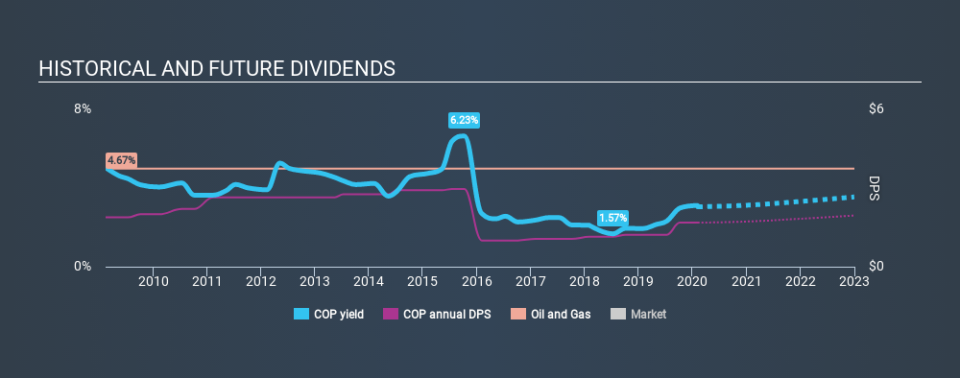Is ConocoPhillips Company (NYSE:COP) A Good Fit For Your Dividend Portfolio?

Could ConocoPhillips Company (NYSE:COP) be an attractive dividend share to own for the long haul? Investors are often drawn to strong companies with the idea of reinvesting the dividends. Yet sometimes, investors buy a stock for its dividend and lose money because the share price falls by more than they earned in dividend payments.
While ConocoPhillips's 2.9% dividend yield is not the highest, we think its lengthy payment history is quite interesting. The company also bought back stock during the year, equivalent to approximately 5.8% of the company's market capitalisation at the time. Some simple research can reduce the risk of buying ConocoPhillips for its dividend - read on to learn more.
Explore this interactive chart for our latest analysis on ConocoPhillips!
Payout ratios
Companies (usually) pay dividends out of their earnings. If a company is paying more than it earns, the dividend might have to be cut. So we need to form a view on if a company's dividend is sustainable, relative to its net profit after tax. Looking at the data, we can see that 19% of ConocoPhillips's profits were paid out as dividends in the last 12 months. Given the low payout ratio, it is hard to envision the dividend coming under threat, barring a catastrophe.
Another important check we do is to see if the free cash flow generated is sufficient to pay the dividend. Of the free cash flow it generated last year, ConocoPhillips paid out 34% as dividends, suggesting the dividend is affordable. It's encouraging to see that the dividend is covered by both profit and cash flow. This generally suggests the dividend is sustainable, as long as earnings don't drop precipitously.
Consider getting our latest analysis on ConocoPhillips's financial position here.
Dividend Volatility
From the perspective of an income investor who wants to earn dividends for many years, there is not much point buying a stock if its dividend is regularly cut or is not reliable. For the purpose of this article, we only scrutinise the last decade of ConocoPhillips's dividend payments. The dividend has been cut on at least one occasion historically. During the past ten-year period, the first annual payment was US$1.88 in 2010, compared to US$1.68 last year. This works out to be a decline of approximately 1.1% per year over that time. ConocoPhillips's dividend has been cut sharply at least once, so it hasn't fallen by 1.1% every year, but this is a decent approximation of the long term change.
We struggle to make a case for buying ConocoPhillips for its dividend, given that payments have shrunk over the past ten years.
Dividend Growth Potential
Given that the dividend has been cut in the past, we need to check if earnings are growing and if that might lead to stronger dividends in the future. ConocoPhillips has grown its earnings per share at 6.8% per annum over the past five years. With a decent amount of growth and a low payout ratio, we think this bodes well for ConocoPhillips's prospects of growing its dividend payments in the future.
Conclusion
Dividend investors should always want to know if a) a company's dividends are affordable, b) if there is a track record of consistent payments, and c) if the dividend is capable of growing. It's great to see that ConocoPhillips is paying out a low percentage of its earnings and cash flow. Unfortunately, earnings growth has also been mediocre, and the company has cut its dividend at least once in the past. ConocoPhillips has a number of positive attributes, but it falls slightly short of our (admittedly high) standards. Were there evidence of a strong moat or an attractive valuation, it could still be well worth a look.
Earnings growth generally bodes well for the future value of company dividend payments. See if the 14 ConocoPhillips analysts we track are forecasting continued growth with our free report on analyst estimates for the company.
We have also put together a list of global stocks with a market capitalisation above $1bn and yielding more 3%.
If you spot an error that warrants correction, please contact the editor at editorial-team@simplywallst.com. This article by Simply Wall St is general in nature. It does not constitute a recommendation to buy or sell any stock, and does not take account of your objectives, or your financial situation. Simply Wall St has no position in the stocks mentioned.
We aim to bring you long-term focused research analysis driven by fundamental data. Note that our analysis may not factor in the latest price-sensitive company announcements or qualitative material. Thank you for reading.

 Yahoo Finance
Yahoo Finance 
